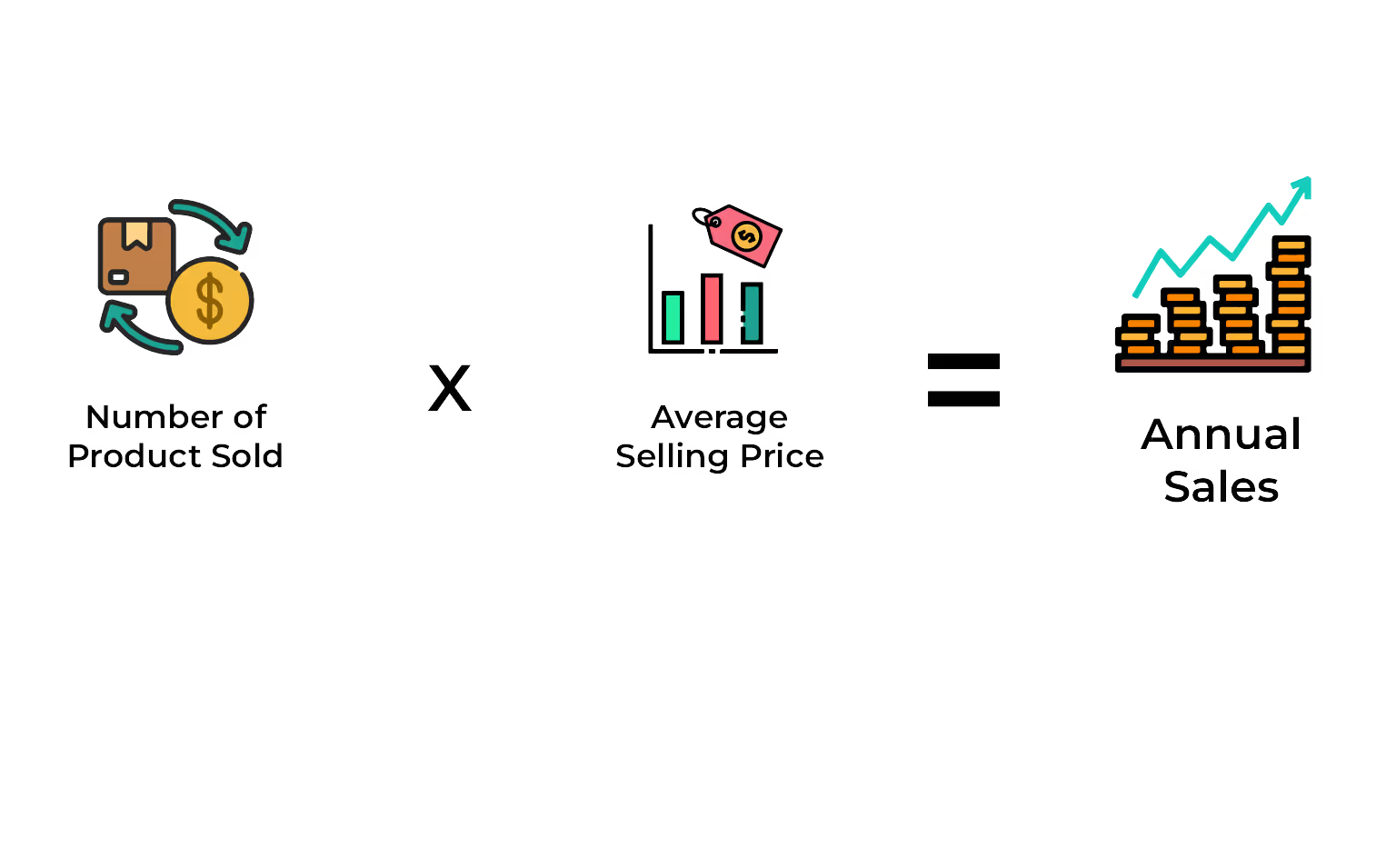
Blog
How Does Annual Sales Help in Forecasting, Planning and Growth?
January 29, 2024


Key Insights
Getting a review of your performance is an essential part of progress and growth. It provides insights into your current position, your strengths, and areas of improvement. It acts as a motivational tool in boosting your performance and productivity.
In this article, we will delve into annual sales, highlighting five reasons to track your annual sales report and ways in which it fosters growth and aids in goal setting. Furthermore, we'll discuss the importance of integrating these insights into your sales meeting agenda for more effective business planning.
So for more reading, scroll down.
What is Annual sales?
Annual sales, also known as sales revenue, refer to the total revenue generated by a company from its primary business operations over a year. It is a key financial metric that is often used to assess a company's financial performance and growth. To gain deeper insights into this metric, businesses can employ a revenue growth calculator to analyze and strategize for sustained financial success.
Calculating annual sales involves multiplying the average selling price per unit by the total number of units sold. Annual sales formula is:

Businesses use sales revenue data for various purposes, such as financial reporting, performance analysis, and strategic planning. It provides insights into a company's ability to generate revenue, market competitiveness, and overall financial health. Additionally, incorporating sales performance feedback into the analysis allows for a more comprehensive understanding of the factors influencing revenue generation and aids in refining strategies for future growth.
5 reasons to track annual sales?

Tracking annual sales is crucial for businesses for several reasons. Let us look at some of the key reasons why monitoring and analyzing annual sales figures is important:
Financial Performance Assessment
Annual sales provide a direct indicator of a company's financial health and performance. Tracking sales over time helps businesses assess their growth, identify trends, and compare performance against previous years. Utilizing advanced incentive compensation management software streamlines the process of tracking sales performance, enabling businesses to effectively manage incentives, align compensation with sales goals, and drive continuous improvement in sales team performance. This information is essential for evaluating the overall success and sustainability of the business.
Budgeting and Planning
Sales revenue figures are fundamental for budgeting and financial planning. They help businesses set realistic revenue targets, allocate resources effectively, and plan for future growth. Understanding sales trends and patterns enables companies to make informed decisions regarding investments, expenses, and expansion strategies.
Investor and Stakeholder Confidence
Investors, shareholders, and other stakeholders closely monitor a company's sales performance. Consistent or growing annual sales can instill confidence in investors and stakeholders, potentially attracting additional investments or support. On the other hand, declining sales may raise concerns and prompt the need for strategic adjustments.
Market and Industry Analysis
Annual sales figures provide valuable insights into a company's position within its market and industry. Comparing sales data to industry benchmarks enhances businesses to measure their market share, competitiveness, and potential areas for improvement. Understanding market dynamics helps companies adapt to changing conditions and stay ahead of the competition.
Performance Metrics and Key Performance Indicators
Annual sales reports are often used as a key performance indicator to measure a company's success. This metric is frequently analyzed alongside other financial and operational KPIs to gain a comprehensive view of performance. Monitoring sales allows businesses to track progress toward goals, identify areas for improvement, and align strategies with organizational objectives.
Tracking sales revenue is integral to financial management, strategic planning, and maintaining stakeholder confidence, making it a crucial metric for evaluating the performance of sales roles. It provides a quantitative basis for decision-making and offers valuable insights into a company's overall health and trajectory.
For further reading, check Boosting Profits: How Sales Revenue Planning Can Transform Your Business?
How does an annual sales report facilitate growth?

Annual sales play a crucial role in forecasting and facilitating growth for a business. Here is how sales revenue figures contribute to these processes:
Historical Performance Analysis
Annual sales data provides a historical record of a company's revenue over time. Analyzing past performance helps identify trends, patterns, and cycles in sales. Understanding historical data empowers businesses to make more accurate predictions about future sales trends and plan for potential challenges or opportunities.
Budgeting and Financial Planning
Annual sales figures are foundational for budgeting and financial planning. When businesses have a clear understanding of their historical sales performance, they can set realistic revenue targets for the upcoming year. This information is crucial for allocating resources effectively, planning expenses, and ensuring that the company is financially prepared for its growth initiatives.
Identifying Growth Opportunities
Examining annual sales data allows businesses to identify successful products, services, or market segments. Companies can focus their efforts on expanding in areas with high potential when they understand what contributes most significantly to overall sales. This targeted approach enables more efficient resource allocation and strategic decision-making for sustainable growth.

Market and Industry Trends
Annual sales figures are essential for tracking a company's performance relative to market and industry trends. Comparing sales data to industry benchmarks and market conditions helps businesses assess their market share and competitiveness. This information helps in adapting strategies to capitalize on emerging opportunities or addressing challenges.
Investor and Stakeholder Confidence
Consistent or growing annual sales figures can enhance investor and stakeholder confidence. When stakeholders see a positive sales trajectory, they are more likely to support the company's growth initiatives. This confidence can attract additional investments, partnerships, and collaborations, providing the financial resources needed for expansion.
Strategic Decision-Making
Annual sales figures serve as a critical input for strategic decision-making. Whether considering new product launches, market expansion, or operational improvements, understanding the sales landscape is essential. Evaluating these figures in the context of an optimized sales team structure enhances the ability to make data-driven decisions, based on historical sales performance. This, in turn, contributes to more informed and strategic choices that align with the company's growth objectives.
Performance Metrics and KPIs
Annual sales reports are often used as a key performance indicator to measure a company's success. Setting sales-related KPIs and regularly monitoring performance against these indicators, including metrics like ACV in SaaS, helps ensure that the business stays on track to achieve its growth goals.
Sales revenue figures are a valuable tool for businesses looking to forecast future performance and plan for growth. Leveraging historical sales data empowers companies to make informed decisions, allocate resources strategically, and position themselves for sustainable and successful expansion.
For further reading, check Discovering Trends and Patterns from Sales History.
How can annual sales help in goal setting?
Annual sales figures play a pivotal role in goal setting for businesses. Analyzing past sales performance companies can set realistic and achievable revenue targets for the upcoming year.
Understanding historical trends enables organizations to identify areas of strength and weakness, guiding the establishment of focused and attainable goals. For instance, if certain products or market segments have consistently performed well, businesses may set goals to further penetrate those areas.
On the other hand, if there are declining trends, goals may be set to address and reverse those challenges. Annual sales data provides a quantitative foundation for goal-setting, aligning strategic objectives with the company's financial capabilities and market dynamics, and fostering a more targeted and achievable approach to growth and success.
For more sales-related reading, visit https://www.kennect.io/. For more information, Book A Demo NOW!
ReKennect : Stay ahead of the curve!
Subscribe to our bi-weekly newsletter packed with latest trends and insights on incentives.
Thank you! Your submission has been received!
Oops! Something went wrong while submitting the form.
Your data is in safe hands. Check out our Privacy policy for more info















